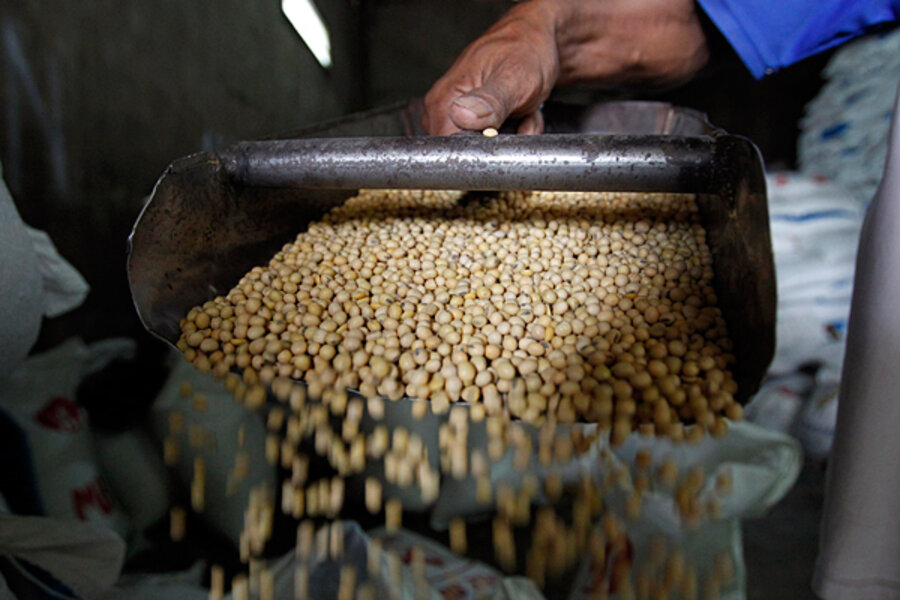US drought already rippling out into the world
Loading...
Much of America's grain belt is gripped in one of the worst droughts in 50 years, and grain prices are already surging.
While that's bad news for America's farmers, the real danger is the effect that will have in poor countries, where even small shifts in prices can have a big impact on the living standards of hundreds of millions of people from Central America to Egypt (the biggest wheat importer in the world) and right across to Indonesia and China.
The US is the world's largest wheat and corn exporter, and its third largest exporter of soybeans. This is less of a case of the beat of a butterfly's wings causing a storm on the other side of the globe then a storm here causing a catastrophe elsewhere. With the northern hemisphere summer less than half over, and no relief in sight for the US drought, the impact of rising food prices globally is set to become a big story in the months ahead.
Globalization has its upsides, but it also means that a peddler in Mexico City or a factory worker in Mumbai is more vulnerable than ever to the whims of North American weather and agricultural policies in the developed world.
Already some places are grappling with the issue. Take Indonesia, where soybeans are used to make tofu, the staple protein for the country's poor. There, soybean prices have risen 33 percent in the past month, and are already causing tensions. Yesterday, there were clashes in Jakarta and other major cities in markets as a coalition of tofu producers sought to enforce a national production strike protesting against a 5 percent soybean import duty.
At the Rawamangun wet market in East Jakarta, members of the Indonesian Tempeh and Tofu Cooperative (Kopti) attacked tofu and tempeh sellers who went against a verbal directive not to sell the two food items. Tofu and tempeh, derived from soybeans and eaten mainly with rice, are staples for many Indonesians as they are among the cheapest sources of protein... Suyanto, head of the East Jakarta chapter of Kopti, said the sweep was aimed to create a common goal between producers and traders as well as demonstrate against high soybean costs. The commodity’s price has risen 33 percent in the past three weeks to Rp 8,000 (85 cents) per kilogram, mainly due to a drought in the United States that has shortened supplies.
The government has already promised to scrap the 5 percent duty on Aug. 1. But you don't have to be a math genius to realize that a 5 percent cut in costs will have little impact on prices that have risen by a third. Indonesia's import duty is to protect local producers in a quest for domestic food security. But in practice, such measures amount to a tax on the country's landless urban factory workers and others among the poorest and continues, despite the government having removed long-standing soybean subsidies at the urging of international organizations like the World Bank and International Monetary Fund four years ago.
Food prices first and foremost affect nutrition, but they can also have profound impacts on the overall health of an economy and society as children are pulled out of school to save money and consumer spending declines as a greater percentage of household incomes are spent on food. And market costs are about more than supply and demand. Speculation and hoarding by traders at times of grain scarcity is almost as old as human history, and will certainly amplify price increases across the globe as this hungry year moves forward.
Earlier this week, researchers at New England Complex Systems Institute, published a paper predicting a surge in prices as speculators pile into grain markets and an impact on the stability of a number of countries.
During the last six years, high and fluctuating food prices have lead to widespread hunger and social unrest. While the spring of 2012 had a relative dip in the food prices, a massive drought in the American midwest in June and July threatens to trigger another crisis... We find that the drought may trigger the expected third food price bubble to occur sooner, before new limits to speculation are scheduled to take effect. Reducing the amount of corn that is being converted to ethanol may address the immediate crisis. Longer term, market stabilization requires limiting financial speculation... Recent food price peaks in 2007-8 and 2010-1 have resulted in food riots and are implicated in triggering widespread revolutions known as the Arab Spring
Is revolutionary upheaval in the offing for the year ahead? Who knows. But it's a safe bet that government planners across the globe are bracing for the worst and working furiously to find solutions.








